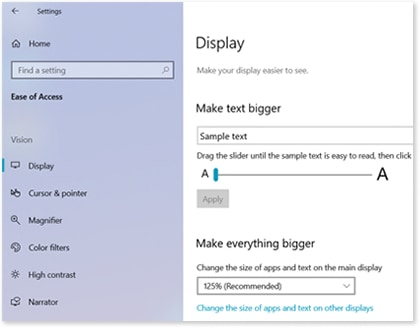Accessibility settings on your Galaxy Book S

The convenient "Ease of Access" settings on the Galaxy Book S are helpful for those with physical impairments. You can alter the display with color filters and high contrast fonts, add closed captions to your screen, or control the device using your voice. The accessibility functions include vision, hearing, and interaction settings so you can choose the options that work best for you.
Information provided applies to devices sold in Canada. Available screens and settings may vary for Galaxy Book S sold in other countries.
If you’re having trouble seeing your screen clearly, you can change the display settings or set up a screen narrator that will guide you through your device. To open Vision settings, select the Start icon, select Settings, and then select Ease of Access.

The following settings will be available:
- Display: Adjust the display features so you can see your screen easily. You can enlarge text, zoom in on apps, change the brightness, and choose notification and animation settings.
- Cursor & pointer: Change the pointer’s size, thickness, and color. Visual screen feedback can be enabled so you know exactly where you’re tapping and clicking.
- Magnifier: Activate a magnifier to enlarge the screen. You can launch the magnifier at sign-in and invert the colors of the screen so it’s easier on your eyes.
- Color filters: Adjust the screen’s colors by applying filters. Filters can be turned on or off, changed to greyscale, or adjusted for colorblindness.
- High contrast: Choose from high contrast themes that improve screen visibility by making hyperlinks and selected texts easier to read.
- Narrator: Activates the screen reader feature, so that the device reads all everything on the screen aloud. This includes text, buttons, apps, and webpages.
Adjust the audio functions on your Galaxy Book S if you have difficulty hearing. To open Hearing settings, select the Start icon, select Settings, and then select Ease of Access. Scroll up to find the Hearing section.

The following options will be available:
- Audio: Adjust the volume for the device, notifications, and individual apps. You can choose visual alerts or disable all sounds completely.
- Closed captions: Your screen will display audio as text when watching videos or movies. The captions, the text background, and the window color can be altered to your liking.
Keyboard and mouse pointer settings can be changed to make things easier if you have mobility concerns. To open Interaction settings, select the Start icon, select Settings, and then select Ease of Access. Swipe up to find Interaction.

The following options will be available:
- Keyboard: Use an on-screen keyboard that can be moved around or minimized. You can switch between the on-screen and physical keyboards seamlessly if you’d like to use both.
- Speech: Speak to your device so it can type for you. You can set up Cortana to assist with things like reminders, opening apps, and sending messages. To enable speech recognition, navigate to Settings, select Windows Ease of Access, and then select Windows Speech Recognition. Use the on-screen prompts to record your voice.
- Mouse: Control the mouse pointer with the keyboard instead of the touchpad and change the pointer’s speed.
- Eye control: Set up an eye tracking device, which allows you to control the mouse pointer, use the on-screen keyboard, and send messages with text-to-speech.
Thank you for your feedback!
Please answer all questions.
The coding for Contact US > Call > View more function. And this text is only displayed on the editor page, please do not delet this component from Support Home. Thank you